Also looks like the great Mike Masters inventory liquidation of July 08 ran its course late in December?
This was a massive, world wide inventory liquidation of just about everything, including housing and financial assets.

[top]

Also looks like the great Mike Masters inventory liquidation of July 08 ran its course late in December?
This was a massive, world wide inventory liquidation of just about everything, including housing and financial assets.

[top]
Let your Washington contacts know I’m available to help them formulate their questions!
SENATE COMMITTEE ON THE BUDGET HOLDS A HEARING ON ECONOMIC AND BUDGET CHALLENGES
MARCH 3, 2009
WITNESSES:
FEDERAL RESERVE SYSTEM BOARD OF GOVERNORS
CHAIRMAN BEN BERNANKE
GREGG: Thank you, Senator Wyden.
And thank you, Mr. Chairman, for attending this hearing today.
I think Senator Wyden, as acting chairman, has touched a core of one of the primary issues I’m interested in, which is the question of confidence. Whether or not the economy recovers depends in large part on the confidence of the American people in the value of their homes and in the fact that they’ll keep the job, confidence of those people
who buy our instruments that are debt is solid and sound, confidence that our currency is strong.
Wrong. It depends on having sufficient income to buy their own outputs and to net save as desired.
In the short run, one can accept the fact that debt is going to go up significantly because of the need to address this economy with the liquidity that only the government can put into it.
But in the long run, one has to ask how can this country sustain a debt to GDP ratio of 67 percent, deficits of over 3 percent, or as far as the eye can see, and expect to maintain the value of the dollar or the ability of people to come and buy our debt?
Like Japan? The yen seems strong enough to me with ratios twice that high.
There is a tsunami of debt headed at us — $66 trillion in unfunded liability. It will essentially overwhelm the capacity of our children to pay it and the ability of this nation to sustain it.
The usual mainstream nonsense.
BERNANKE: By December the Federal Open Market Committee had brought its target for the federal funds rate to an historically low range of zero to .25 percent, where it remains today.
(Which has removed maybe $200 billion annually in net interest income for the non government sectors)
Unfortunately,
Here we go. Deficits per se are bad.
the spending for financial stabilization, the increases in spending and reductions in taxes associated with the fiscal package, and the losses in revenues and increases in income- support payments associated with the weak economy will widen the federal budget deficit substantially this year. Taking into account these factors, the administration recently submitted a proposed budget that projects the federal deficit to increase to about $1.8 trillion this fiscal year and to remain around $1 trillion in 2010 and 2011.
As a consequence of this elevated level of borrowing, the ratio of federal debt held by the public to nominal GDP is likely to move up from about 40 percent before the onset of the financial crisis to more than 60 percent over the next several years, its highest level since the early 1950s, in the years following the massive debt buildup
during World War II.
Of course, all else equal, this is a development that all of us would have preferred to avoid.
He’s obviously in a fixed FX paradigm
We are better off moving aggressively today to solve our economic problems. The alternative could be a prolonged episode of economic stagnation that would not only contribute to further deterioration in the fiscal situation,
As if that’s the larger issue
but would also imply lower output, employment and incomes for an extended period.
Of secondary importance to the deficit issue.
With such large near-term deficits, it may seem too early to be contemplating the necessary return to fiscal sustainability. To the contrary, maintaining the confidence of the financial markets requires that we begin planning now for the restoration of fiscal balance.
Not true.
As the economy recovers and resources become more fully employed, we will need to withdraw the temporary components of the fiscal stimulus. Spending on financial stabilization also must wind down. If all goes well, the disposition of assets acquired by the Treasury in the process of stabilization will be a source of added revenue for the Treasury in the out years.
How about instead:
Whatever it takes to sustain output and employment is the right fiscal and policy.
Determining the pace of fiscal normalization will entail some difficult judgments. In particular, the Congress will need to weigh the costs of running large budget deficits for a time
What costs?
against the possibility of a premature removal of fiscal stimulus that could blunt the recovery.
That’s a real cost.
We at the Federal Reserve will face similar difficult judgment calls regarding monetary policy.
In particular, policy-makers must remain prepared to take the actions necessary in the near term to restore stability to the financial system and to put the economy on a sustainable path to recovery. But the near-term imperative of achieving economic recovery and the longer-run desire to achieve programmatic objectives should not be allowed to hinder timely consideration of the steps needed to address fiscal imbalances.
Why are they imbalances???
There are no gold reserves that can be depleted due to a convertible currency.
Without fiscal sustainability,
Fortunately, that isn’t an operational issue.
in the longer term we will have neither financial stability nor healthy economic growth.
Thank you for your attention. I’m happy to take your questions.
Senator Gregg?
GREGG: Thank you, Mr. Chairman.
And after that is all said and done, four years from now, when one certainly hopes, presumes and expects that we will be beyond these dire economic situations, we will be looking at a government which is taking up 22 percent of the gross national product,
(Probably the lowest in the world)
has a 67 percent ratio of publicly held debt to the GDP, and no end in sight and, in fact, it continues to work its way up, with deficits running at three to four percent, minimum, from 2013 to 2019, which is the end of the
window for this budget.
Reads like conditions for stability to me.
BERNANKE:GREGG: But your place is to protect the value of the dollar and protect the ability …
GREGG: … to sell the debt…
BERNANKE: … go on to say my concern here, as I expressed, was that there needs to be fiscal sustainability. If government spending is higher, it needs to be recognized that that will involve higher taxes in order to maintain a close reasonable balance between revenue and outlays.
So his target is a ‘close reasonable balance’.
That does have some implications for efficiency of the economy.
Does have some implications for efficiency? Is that all? Not that there is such a thing in the first place.
BERNANKE: Well, Senator, the CBO, for example, has done simulations which show that in 2030, under current laws, Medicare, Medicaid and Social Security would take up about, alone, would take up about 16 percent of GDP, which is pretty close to non-interest spending. It’s pretty close to the entire federal non-interest budget.
So it’s clear that in order to get control over the overall budget situation, we’re going to need to look at entitlements.
We don’t have the real resources to give the elderly a modest minimum standard of living and we don’t have the real resources to look after our health???
The current excess capacity alone is more than enough to do both.
If we don’t get a sustainable fiscal situation and deficits continue in large amounts for a long period, then it will become more difficult to sell our debt and interest rates will rise and it will be counterproductive.
Like Japan?
BERNANKE:Yes. So there’s been a lot of talk about banks and their ability to lend. In fact, for many types of credit, nonbank securitization markets are the main source of funding and those markets have largely closed down.
And so by restoring and re-stimulating activity in securitization markets, we hope to get credit flowing for a number of different critical areas.
We can’t ‘get credit going’ without securitization?
Of course we can!
The Fed could easily enable the banks, their legally designated agents, to do this with similar funding and guarantees.
Senator Cardin?
GRAHAM: Thank you, Mr. Chairman.
I’m trying to ask Senator Gregg’s question a little bit differently. Is there any outer limit on the federal government’s ability to borrow money?
BERNANKE: Certainly, there are outer limits.
Really??
GRAHAM: What are they and how close are we to them?
BERNANKE:Well, it’s — it’s hard — it’s hard to — to judge in any kind of explicit way, since we don’t — don’t know. I mean there are countries have clearly — for short periods of time has clearly had very high levels of debt.
Like Japan? For almost 20 years?
The United States had more than 100 percent debt to GDP ratio during World War II. The Japanese during their financial crisis raised the debt to GDP ratio above 100 percent.
Above 150% for considerable periods of time.
But clearly, that’s not a healthy situation.
Clearly?
It’s one in which interest payments can become a very important part of the — of the government’s outlays.
The Fed sets those interest rates. And Congress taxes interest income.
Nor operationally is the ability to make payments revenue constrained.
We had been — over years had been bringing our debt to GDP ratio down to about 40 percent. Now we’re going to see a jump to 60 or 65 percent.
We need to be I think looking for a — what’s called a primary deficit — that is, the deficit excluding interest payments, a somewhere close to balance. That would be sufficient to stabilize our debt to GDP ratio. I think that would be a good objective.
Interesting, more gold standard rhetoric.
How about an objective like optimal output and employment?
It’s very hard to know how much higher — how much higher the debt to GDP ratio could be before the international financial markets begin to — to balk. And so I think the prudent thing to do is to try and maintain stability of the debt to GDP ratio.
Like Japan, where 10 year JGB’s are under 1.5%, outstanding securities are over 150% of GDP, deficits range to over 8% of GDP, and they’ve been downgraded below Botswana???
Government rates go to where the CB sets them, end of story.
GRAHAM: Has there always been a buffer zone to — between reality and this magical place? And is there a buffer zone today?
BERNANKE: Well, as — as I think the recent experience is showing, confidence and expectations are critical.
Yes, he truly believes this.
And I think the markets will be quite able to absorb, for example, the large amount of issuance we’re seeing in the next couple of years, if there is a reasonable expectation and confidence in the same markets that the United States is serious about getting its budget position under control in the longer-term.
He truly believes that’s the case.
GRAHAM: There are some projections that exist that in 2050 the debt to GDP will be 300 percent. What kind of effect will that have, if that became a reality?
BERNANKE: Well, I don’t think that’s going to happen. It can’t happen, because things would break down before then.
GRAHAM: Something has to change first.
BERNANKE: Something…
GREGG: Happen, but not to change.
BERNANKE:That’s right.
GREGG: For it not to happen, right? Something has to change.
BERNANKE: Something would change, whether it was either change in policy or change in the willingness of the — of the lenders to finance the debt.
What generally changes is inflation keeps the nominal debt to GDP ratio down, but that’s another story that he knows well. And the reason he doesn’t want to go there is because that story says the risks are inflation and not solvency or the ability to sell securities.
GRAHAM: I’ve only got 15 seconds. My question, basically, is will we ever know in this country whether or not we’re repeating the Japanese mistake? Do you have any test out there to let us in Congress know that we’re throwing good money after bad, when it comes to certain institutions?
BERNANKE: The Japanese mistake was not acting quickly enough or aggressively enough, and I think that’s not our problem.
Yes, on fiscal policy.
SANDERS: Thank you, Mr. Chairman.
ALEXANDER: But — but they are (inaudible) to — to specify — the first risk is that you don’t get your money back. You think you will. The second risk would be that you’d — the more paper — the more money you print, the more likely we have inflation down the road…
(CROSSTALK)
BERNANKE: Senator, that’s aptly correct. So you’re absolutely right that in order for us to begin to raise interest rates and begin to stabilize the economy.
Now that they can pay interest on reserves they don’t have to ‘shrink the balance sheet’ to raise rates. Bernanke should know that.
At that time when the economy begins to grow again, we’re going to have to shrink the balance sheet and we are very comfortable — we’re watching that very, very carefully. It’s very important. We spend about half of our time at FOMC meetings, looking at the balance sheet and trying to make that evaluation.
Interesting use of FOMC time!
Worrying about something of no consequence whatsoever.
[top]
(email exchange)
Yes, classic!
>
> On Wed, Mar 4, 2009 at 9:32 AM, Joshua wrote:
>
> Regardless of our feelings towards deficits and debt, we have to be proud of our
> knowledgeable politicians…see below…
>
> Here’s the transcript: Stunning
>
HOUSE COMMITTEE ON WAYS AND MEANS
WASHINGTON, D.C.
REP. CHARLES B. RANGEL HOLDS A HEARING ON THE PRESIDENT’S BUDGET
PROPOSAL FOR FISCAL YEAR 2010
MARCH 3, 2009
SPEAKERS:
REP. CHARLES B. RANGEL, D-N.Y.
CHAIRMAN
REP. PETE STARK, D-CALIF.
REP. SANDER M. LEVIN, D-MICH.
REP. JIM MCDERMOTT, D-WASH.
REP. LINDA T. SANCHEZ, D-CALIF.
SANCHEZ: Thank you, Mr. Chairman.
And thank you, Secretary Geithner, for being with us this afternoon. I was absent for part of the hearing, so pardon me if I’m asking questions that have already been answered. But I know that a lot of criticism has been leveled at this budget because of a fear of future debt. That’s what we keep hearing. We can’t burden, you know, future generations. My question to you is a very specific one. Do we really need to balance the budget in order to reduce our future deficit — or our future — pardon me — debt burden, or can we reduce our debt burden while still running deficits, because some people would have you believe that the two must go hand in hand?
[top]
Excellent, thanks!
This excellent BIS report reveals the data behind the world dollar shortage including the role of the Fed swap lines in keeping the eurozone life support.
>
> On Mon, Mar 2, 2009 at 10:45 PM, Sean wrote:
>
[top]
Seems the prospect of euro nations going to the IMF has struck a raw nerve.
No doubt any plan to access ECB funding would include some kind of austerity condition similar to what the IMF would require.
This would weaken aggregate demand in the entire region.
They must be a lot more worried about a default than they are letting on.
>
> On Wed, Mar 4, 2009 Dave wrote:
>
> Greece just sold Eur7.5bn 10 yr bonds 50bp cheaper on ASW levels from 2 days ago…..
>
> ”Euro area members will not default. Without getting into the details, European
> Commissioner for Economic & Monetary Affairs, Joaquin Almunia, confirms that there
> exists a solution for euro area member states threatened with default. As our FI strategists
> pointed out in their 2009 Outlook piece in December, despite the Maastrich Trearty “no
> bail out” clauses, Article 122 of the EU Treaty allows financing of member states in
> exceptional circumstances. Almunia doesn’t want to flesh out how this financing would
> work, but at least he is verifying that a financing facility exists for struggling euro zone
> members.
>
Eurozone can bail out members if needed – Almunia
by Jan Strupczewski and Marcin Grajewski
Mar 3 (Reuters) — The euro zone has a way of bailing out its members if they face a crisis before they have to seek IMF help, but this must remain confidential, European Monetary Affairs Commissioner Joaquin Almunia said on Tuesday.
Although no bailout possibility existed under European Union laws for euro zone countries, there was a solution that could be used, Almunia told a seminar.
“If a crisis emerges in one euro area country, there is a solution…
Before visiting the IMF, you can be sure there is a solution and you can be sure that it is not clever to talk in public about this solution,” he said.
“But this solution exists. Don’t fear for this moment — we are equipped intellectually, politically and economically to face this crisis scenario, but by definition these kinds of things should not be explained in public,” he said.
German Finance Minister Peer Steinbrueck said in February that although EU rules said countries should not help each other within the currency area, all members of the bloc would have to help “if it came to a serious situation”.
In the same speech he mentioned Ireland as being in a “very difficult situation”. Other euro zone countries such as Greece have seen their bond spreads over Germany widen, reflecting worries about rising budget deficits and sparking market speculation about the possible break-up of the euro zone.
Almunia reiterated on Tuesday no such option existed. “The probability of this happening is zero. Who is crazy enough to leave the euro area?
Nobody.
How many candidates to join the euro area I know? A number that is bigger than last year,” he said.
German Foreign Minister Frank-Walter Steinmeier also said on Feb. 20 that a process had begun to consider how financially strong euro zone nations could help weaker members, though it was too early to say what measures might be taken.
[top]
As I’ve said for a very long time, the last thing we need is a billion new consumers in the world competing for resources.
But by failing to unilaterally sustain domestic demand at a time when the rest of the world wants to export to us, we are causing exactly that to happen.
It’s still not too late as China remains leveraged to exports, but that will change if that channel remains closed.
China Manufacturing Index Rises on Stimulus Spending
by Li Yanping and Nipa Piboontanasawat
Mar 4 (Bloomberg) — A Chinese manufacturing index climbed for a third month, adding to evidence that a 4 trillion yuan ($585 billion) stimulus package is pushing the world’s third-biggest economy closer to a recovery.
The Purchasing Manager’s Index rose to a seasonally adjusted 49 in February from 45.3 in January, the China Federation of Logistics and Purchasing said today in an e-mailed statement. A reading below 50 indicates a contraction.
Stocks rose after output and new orders expanded for the first time in five months. Chinese Premier Wen Jiabao may announce extra measures to reverse the nation’s economic slide at the annual meeting of the National People’s Congress starting in Beijing tomorrow.
“There are more noticeable signs that China’s economy is bottoming out,†said Zhang Liqun, an economist at the State Council Development and Research Center.
The Shanghai Composite Index rose 2.4 percent as of 10:47 a.m. local time.
While manufacturing contracted for a fifth straight month as the worst financial crisis since the Great Depression cut exports, the PMI is up from a record low of 38.8 in November.
Surging loans, growth in retail sales in January, and an increase in electricity output and consumption from the middle of last month are signs that government measures have shown “preliminary results,†according to Premier Wen.
Recovery ‘Very Likely’
A recovery in the first half is “very likely,†central bank Vice Governor Su Ning said yesterday.
Industrial-output growth in January and February may be higher than in November and December, Zhang forecast. Still, he cautioned that “seasonal factors†may have boosted the output and new-order indexes, which could fall again.
“The government’s stimulus investment has finally started to take effect,†said Xing Ziqiang, an economist at China International Capital Corp. in Beijing. “However, a recovery may be short-lived as export demand may get worse in the second half and the outlook for consumption is uncertain.â€ÂÂ
The manufacturing index likely got a boost from factories resuming production after a Chinese Lunar New Year holiday in January, Xing said.
The output index jumped to 51.2 from 45.5 in January and the new-order index climbed to 50.4 from 45.
Export Orders
A measure of export orders rose to 43.4 from 33.7. The employment index rose to 46.1 from 43, the first increase in six months.
The premier may unveil a record 950 billion yuan budget deficit for this year to cover government spending on the economy and welfare, according to the China Business Journal and Wen Wei Po newspapers.
The slowdown has triggered speculation that the government will increase the stimulus package announced in November. An unidentified planning-agency official said today that more will be spent, Reuters reported.
Officials have indicated 8-10 trillion yuan of “government-sponsored investment†is possible, Stephen Green, Shanghai-based head of China research at Standard Chartered Bank Plc said yesterday.
A separate purchasing managers’ index, released on March 2 by CLSA Asia-Pacific Markets, showed manufacturing contracted for a seventh month in February.
“Manufacturing activities may only start to recover from March after more projects break ground in spring,†said Sun Mingchun, an economist at Nomura Holdings Ltd. in Hong Kong. “Economic growth may start to pick up from the second quarter onwards.â€ÂÂ
Steel Glut
A glut of steel at ports in China, the world’s biggest maker of the alloy, shows mills were too quick to boost output on expectations the stimulus package unveiled in November would spur demand, according to Bank of Nova Scotia.
Steel stockpiles at Shanghai’s main port have jumped 44 percent this year to 2.1 million metric tons on Feb. 27, the highest since Bloomberg began compiling the data in June 2006.
While China’s economy is the only one of the world’s five biggest still expanding, the pace has slowed for six straight quarters. Growth in the three months through December was 6.8 percent from a year earlier, the smallest gain in seven years. That compares with a 13 percent expansion for all of 2007.
Tongling Nonferrous Metals Group Co., China’s second- biggest copper smelter by output, said Feb. 27 that profit tumbled last year after prices slumped in the fourth quarter.
Lenovo Group Ltd., the world’s fourth-biggest personal- computer maker, said Feb. 25 that it will cut 450 jobs in China to reduce costs after demand fell in the U.S. and China.
20 Million Jobs
China’s government said last month that 20 million migrant workers had lost their jobs because of the slowdown.
Jia Qinglin, a member of the Communist Party’s Politburo, urged a “vigorous employment policy†in his speech yesterday at the opening meeting of the Chinese People’s Political Consultative Conference.
“China will pick up in the second half of this year as the stimulus package†begins working, Vivek Tulpule, the chief economist at London-based Rio Tinto Group, said yesterday in Canberra, Australia. Rio is the world’s third-biggest mining company.
[top]
(email exchange)
Yes, thanks!
>
> On Tue, Mar 3, 2009, Bill wrote:
>
> John Adams once wrote in a letter to Thomas Jefferson:
>
> ”All the perplexities, confusion and distresses in America arise not from defects in the
> constitution or confederation, nor from want of honor or virtue, as much from downright
> ignorance of the nature of coin, credit, and circulation.”
>
[top]
(email exchange)
Thanks, along with the personal income data, and the end of the inventory liquidations through most of December, seems to be early anecdotal evidence of a flattening after year end. Several other series have had minor turns up as well.
(0 GDP growth still means rising unemployment)
>
> On Tue, Mar 3, 2009 at 3:41 PM, Russell wrote:
>
ATA Truck Tonnage Index Rose 3 Percent in January
by Connie Heiss
Feb 27 (ATA Trucking) — From the American Trucking Association: ATA Truck Tonnage Index Rose 3 Percent in January
The American Trucking Associations’ advanced seasonally adjusted For-Hire Truck Tonnage Index climbed 3 percent in January 2009, marking only the second month-to-month increase in the last seven months. Still, the gain did little to erase the revised 7.8 percent contraction in December 2008. In January, the seasonally adjusted tonnage index equaled just 104.7 (2000 = 100), its second-lowest level since October 2002. …
Compared with January 2008, the index declined 10.8 percent, which was slightly better than December’s 12.5 percent year-over-year drop.
ATA Chief Economist Bob Costello said that there was no reason to get excited about January’s 3 percent month-to-month improvement. “Tonnage will not fall every month, and just because it rises every now and then doesn’t mean the economy is on the mend,†Costello said. “Furthermore, tonnage is contracting significantly on a year-over-year basis, which is highlighting the current weakness in the freight environment.â€ÂÂ
[top]
It all still looks very, very weak. But so low that even small improvements will show high % gains.
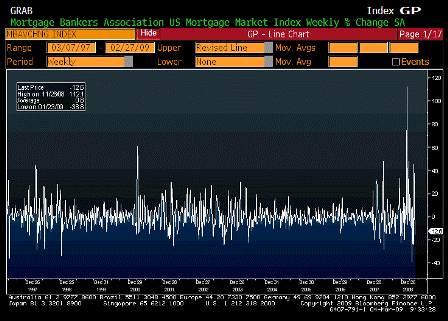
| Survey | n/a |
| Actual | -12.6% |
| Prior | -15.1% |
| Revised | n/a |

| Survey | n/a |
| Actual | 236.40 |
| Prior | 250.50 |
| Revised | n/a |

| Survey | n/a |
| Actual | 3063.40 |
| Prior | 3618.00 |
| Revised | n/a |
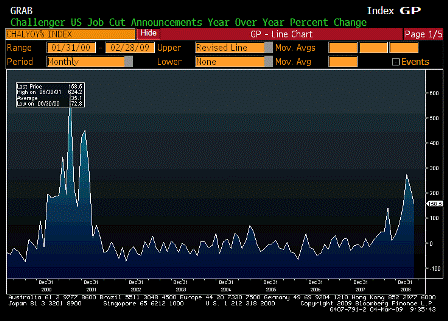
| Survey | n/a |
| Actual | 158.49% |
| Prior | 222.40% |
| Revised | n/a |
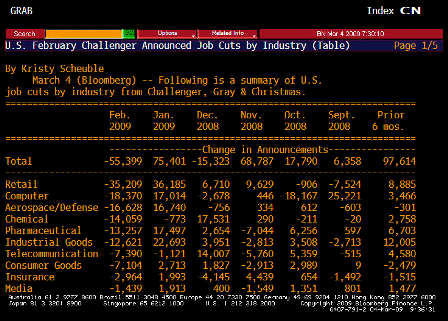
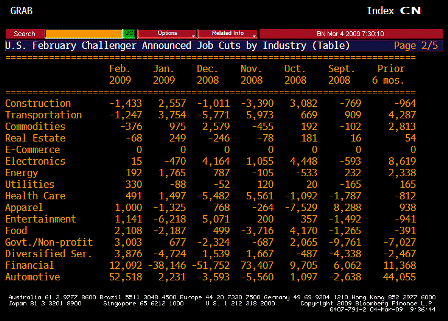
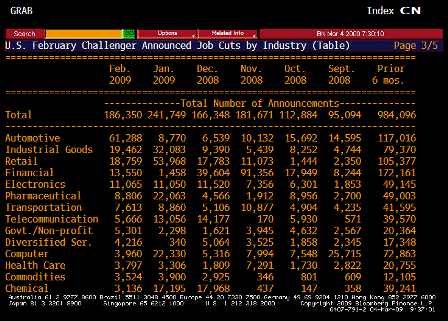
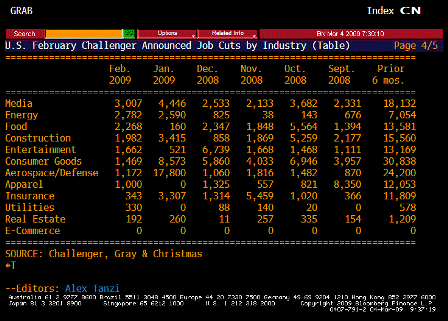
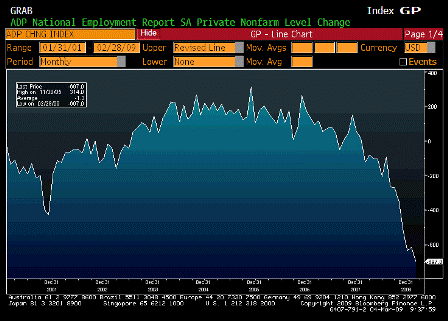
| Survey | -630K |
| Actual | -697K |
| Prior | -522K |
| Revised | -614K |
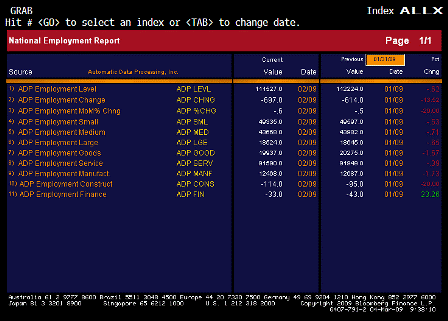
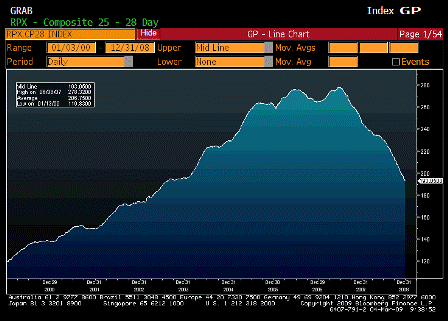
| Survey | n/a |
| Actual | 193.05 |
| Prior | 199.39 |
| Revised | n/a |
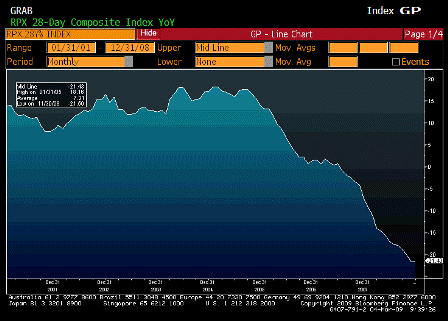
| Survey | n/a |
| Actual | -21.43% |
| Prior | -21.59% |
| Revised | n/a |
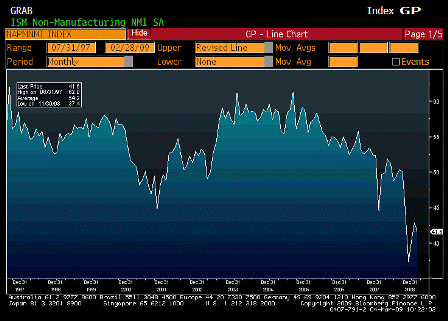
| Survey | 41.0 |
| Actual | 41.6 |
| Prior | 42.9 |
| Revised | 42.9 |
[top]